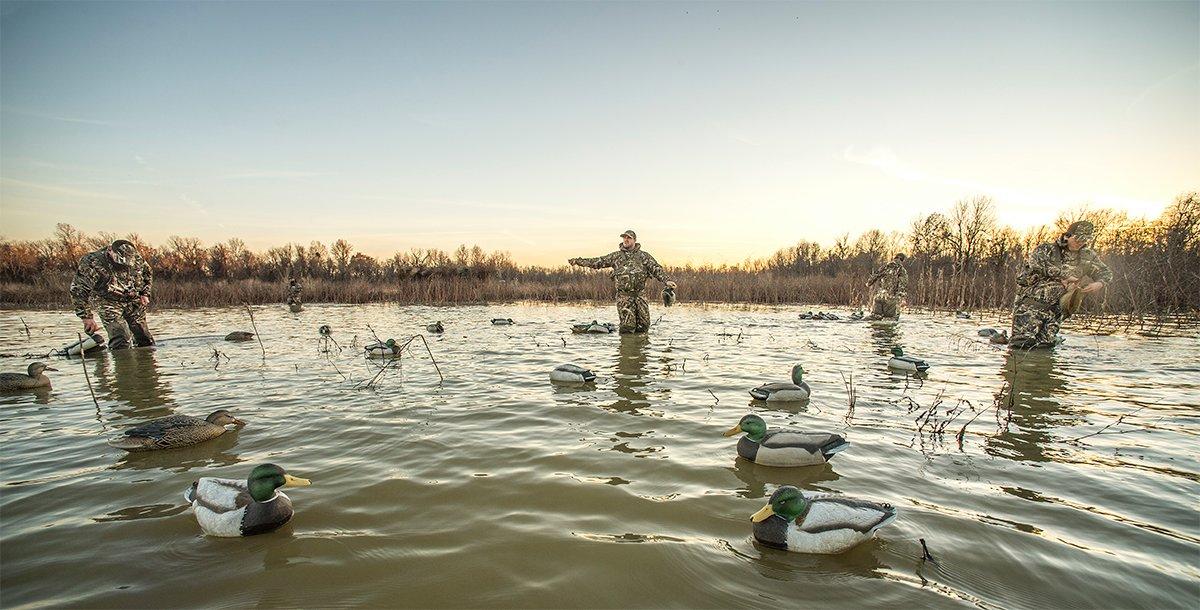Need a Quick Fix to a Pesky Dilemma? Ask the Experts
Like most folks, waterfowlers have problems; some — that is, me — more than others, but that's a story for another time.
But back to the subject. From time to time, waterfowlers get frustrated. This doesn't work. That doesn't work. No, we're not looking for easy, simple answers. But wouldn't it be nice to have a trouble-shooting guide specifically for duck and goose hunters?
Realtree.com does just that, thanks to these experienced problem solvers from across the country.
Bobby Guy
Hometown: Hutchinson, Kansas
Occupation: full-time waterfowl YouTuber
Years hunting waterfowl: 14
Notes: BobbyGuyFilms, YouTube
The problem: late-season mixed Canadas. You're running big spreads consisting of some full-bodies but about 80 percent silhouettes and socks. You're having problems finishing birds. They want to slide or are flaring at 75 yards and farther.
Why: One of the reasons for this, I think, is a combination of weather and the birds. If you're working with geese that have been around a while, like we are this year in Kansas (the geese arrived early and then never left), silhouettes and socks just don't seem to work as well. Also, silhouettes and socks should be set differently from full-bodies to work effectively.
The fix: When I set silhouettes and socks, I set them extra wide. And the wider, the better. My thought is that these types of decoys work best when seen in the birds' peripheral vision — that is, to the sides (of their anticipated approach) rather than head-on. And I don't set a true hole when running silhouettes or socks. Go wide and random.
Travis Madden
Hometown: Lehi, Utah
Occupation: sales and service, Backwater Performance Systems
Years hunting waterfowl: 20
Notes: pro-staff for Avery Outdoors
The problem: You're running a new acrylic single-reed mallard call, and the darn thing keeps locking up. Or worse, it's squealing. What the heck?
Why: A couple of things. The call could be sticking. That is, the reed is being held down by moisture and not being allowed to spring up. Or you're squealing the call, maybe over-blowing it or over-pressurizing it, causing it to squeal.
The fix: The key is proper technique. To help with sticking, bring the air from your throat rather than spitting into the call. You could change the cord out, too. Or, you can try blowing the call purposely with the tone board facing down. This can help prevent the reed from sticking on the board. For squealing, try to keep your throat open and bring air up from your diaphragm. Think fogging a mirror, not trying to cool off a bowl of soup. Also, you could have the call tuned lighter or even swap out for a heavier/longer reed.
Travis Lyle
Hometown: Hawthorne, Nevada
Occupation: NV Cement Co.
Years waterfowl hunting: 25
Notes: Pro-Staff for Banded Inc.
The problem: You're working with lots of gadwalls. They have the irritating habit of circling and circling, and then landing way out in the middle of things, outside of gun range.
Why: Over mallard spreads, I've often seen gadwalls show a tendency to light wide. Honestly, I'm not sure why. The decoys might be too close together. Maybe it's the spinners or the blind.
The fix: First, get out of the blind and really look things over. Then, pull the spinners, and make the hole bigger. If you're not already doing it, put some motion on the water, like a jerk cord or shakers. Try pulling the entire spread in closer. You're running a lot of gadwall decoys, right? Call on the corners, use a wigeon whistle, and invest in a gadwall call. Sometimes, they seem to like their own sound best.
Geff Duncan
Hometown: Chehalis, Washington
Occupation: owner, Disce Pati Farms and Fencing
Years waterfowl hunting: 13
Notes: pro-staff for Avery Outdoors
The problem: You've found a honey hole with ducks and geese, and the plan is to hunt over a mixed spread. Thing is, you have to decide on a shot size that will work equally as well for mallards and Canadas without racking round No. 1 out and switching shells.
Why: If your shot is too small, you won't have the knockdown power for the big geese. If it's too large, you're dealing with a pellet count and pattern density issue.
The fix: My favorite mixed load (ducks and geese over decoys) is 12-gauge 3-inch No. 2 shot. Get them inside 40 yards, and No. 2s will work just fine. But it's important to make sure your hide is good and you're letting the birds finish within 40 yards or closer. Also, make sure you're using the right choke. A traditional modified choke often works well, as can one of the many aftermarket.
Author's note: And, before the season, pattern that gun with various shot sizes and, if possible, choke tubes. Turkey hunters do it religiously. Waterfowlers should, too.
Click here for more Realtree waterfowl hunting content. And check us out on Facebook.








